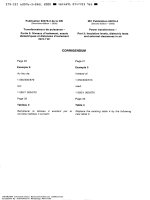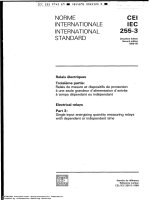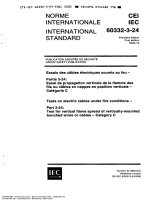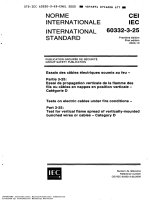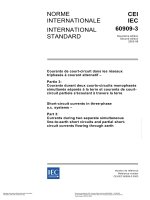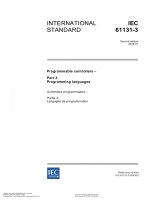Iec 60747 3 2013
Bạn đang xem bản rút gọn của tài liệu. Xem và tải ngay bản đầy đủ của tài liệu tại đây (572.48 KB, 74 trang )
®
Edition 2.0 2013-07
INTERNATIONAL
STANDARD
NORME
INTERNATIONALE
colour
inside
Semiconductor devices –
Part 3: Discrete devices: Signal, switching and regulator diodes
IEC 60747-3:2013
Dispositifs à semiconducteurs –
Partie 3: Dispositifs discrets: Diodes de signal, diodes de commutation et diodes
régulatrices
Copyrighted material licensed to BR Demo by Thomson Reuters (Scientific), Inc., subscriptions.techstreet.com, downloaded on Nov-27-2014 by James Madison. No further reproduction or distribution is permitted. Uncontrolled when printe
IEC 60747-3
All rights reserved. Unless otherwise specified, no part of this publication may be reproduced or utilized in any form
or by any means, electronic or mechanical, including photocopying and microfilm, without permission in writing from
either IEC or IEC's member National Committee in the country of the requester.
If you have any questions about IEC copyright or have an enquiry about obtaining additional rights to this publication,
please contact the address below or your local IEC member National Committee for further information.
Droits de reproduction réservés. Sauf indication contraire, aucune partie de cette publication ne peut être reproduite ni
utilisée sous quelque forme que ce soit et par aucun procédé, électronique ou mécanique, y compris la photocopie et les
microfilms, sans l'accord écrit de la CEI ou du Comité national de la CEI du pays du demandeur.
Si vous avez des questions sur le copyright de la CEI ou si vous désirez obtenir des droits supplémentaires sur cette
publication, utilisez les coordonnées ci-après ou contactez le Comité national de la CEI de votre pays de résidence.
IEC Central Office
3, rue de Varembé
CH-1211 Geneva 20
Switzerland
Tel.: +41 22 919 02 11
Fax: +41 22 919 03 00
www.iec.ch
About the IEC
The International Electrotechnical Commission (IEC) is the leading global organization that prepares and publishes
International Standards for all electrical, electronic and related technologies.
About IEC publications
The technical content of IEC publications is kept under constant review by the IEC. Please make sure that you have the
latest edition, a corrigenda or an amendment might have been published.
Useful links:
IEC publications search - www.iec.ch/searchpub
Electropedia - www.electropedia.org
The advanced search enables you to find IEC publications
by a variety of criteria (reference number, text, technical
committee,…).
It also gives information on projects, replaced and
withdrawn publications.
The world's leading online dictionary of electronic and
electrical terms containing more than 30 000 terms and
definitions in English and French, with equivalent terms in
additional languages. Also known as the International
Electrotechnical Vocabulary (IEV) on-line.
IEC Just Published - webstore.iec.ch/justpublished
Customer Service Centre - webstore.iec.ch/csc
Stay up to date on all new IEC publications. Just Published
details all new publications released. Available on-line and
also once a month by email.
If you wish to give us your feedback on this publication
or need further assistance, please contact the
Customer Service Centre:
A propos de la CEI
La Commission Electrotechnique Internationale (CEI) est la première organisation mondiale qui élabore et publie des
Normes internationales pour tout ce qui a trait à l'électricité, à l'électronique et aux technologies apparentées.
A propos des publications CEI
Le contenu technique des publications de la CEI est constamment revu. Veuillez vous assurer que vous possédez
l’édition la plus récente, un corrigendum ou amendement peut avoir été publié.
Liens utiles:
Recherche de publications CEI - www.iec.ch/searchpub
Electropedia - www.electropedia.org
La recherche avancée vous permet de trouver des
publications CEI en utilisant différents critères (numéro de
référence, texte, comité d’études,…).
Elle donne aussi des informations sur les projets et les
publications remplacées ou retirées.
Le premier dictionnaire en ligne au monde de termes
électroniques et électriques. Il contient plus de 30 000
termes et définitions en anglais et en franỗais, ainsi que
les termes ộquivalents dans les langues additionnelles.
Egalement
appelé
Vocabulaire
Electrotechnique
International (VEI) en ligne.
Just Published CEI - webstore.iec.ch/justpublished
Restez informé sur les nouvelles publications de la CEI.
Just Published détaille les nouvelles publications parues.
Disponible en ligne et aussi une fois par mois par email.
Service Clients - webstore.iec.ch/csc
Si vous désirez nous donner des commentaires sur
cette publication ou si vous avez des questions
contactez-nous:
Copyrighted material licensed to BR Demo by Thomson Reuters (Scientific), Inc., subscriptions.techstreet.com, downloaded on Nov-27-2014 by James Madison. No further reproduction or distribution is permitted. Uncontrolled when printe
THIS PUBLICATION IS COPYRIGHT PROTECTED
Copyright © 2013 IEC, Geneva, Switzerland
®
Edition 2.0 2013-07
INTERNATIONAL
STANDARD
NORME
INTERNATIONALE
colour
inside
Semiconductor devices –
Part 3: Discrete devices: Signal, switching and regulator diodes
Dispositifs à semiconducteurs –
Partie 3: Dispositifs discrets: Diodes de signal, diodes de commutation et diodes
régulatrices
INTERNATIONAL
ELECTROTECHNICAL
COMMISSION
COMMISSION
ELECTROTECHNIQUE
INTERNATIONALE
PRICE CODE
CODE PRIX
ICS 31.080.10
V
ISBN 978-2-8322-0897-7
Warning! Make sure that you obtained this publication from an authorized distributor.
Attention! Veuillez vous assurer que vous avez obtenu cette publication via un distributeur agréé.
® Registered trademark of the International Electrotechnical Commission
Marque déposée de la Commission Electrotechnique Internationale
Copyrighted material licensed to BR Demo by Thomson Reuters (Scientific), Inc., subscriptions.techstreet.com, downloaded on Nov-27-2014 by James Madison. No further reproduction or distribution is permitted. Uncontrolled when printe
IEC 60747-3
60747-3 © IEC:2013
CONTENTS
FOREWORD ........................................................................................................................... 4
1
Scope ............................................................................................................................... 6
2
Normative references ....................................................................................................... 6
3
Terms, definitions and graphical symbols ......................................................................... 6
4
3.1 Signal and switching diodes .................................................................................... 6
3.2 Voltage reference diodes and voltage regulator diodes ............................................ 7
3.3 Current-regulator diodes .......................................................................................... 8
Letter symbols .................................................................................................................. 9
4.1
4.2
5
General ................................................................................................................... 9
Signal and switching diodes .................................................................................... 9
4.2.1 Subscripts ................................................................................................... 9
4.2.2 List of letter symbols.................................................................................... 9
4.3 Voltage reference diodes and voltage regulator diodes .......................................... 10
4.3.1 Subscripts ................................................................................................. 10
4.3.2 List of letter symbols.................................................................................. 10
4.4 Current-regulator diodes ........................................................................................ 10
4.4.1 Subscripts ................................................................................................. 10
4.4.2 List of letter symbols.................................................................................. 11
Essential ratings and characteristics ............................................................................... 11
5.1
5.2
6
General ................................................................................................................. 11
Signal and switching diodes .................................................................................. 11
5.2.1 Ratings (limiting values) ............................................................................ 11
5.2.2 Characteristics .......................................................................................... 11
5.3 Voltage reference diodes and voltage regulator diodes .......................................... 14
5.3.1 Ratings (limiting values) ............................................................................ 14
5.3.2 Characteristics .......................................................................................... 14
5.4 Current-regulator diodes ........................................................................................ 16
5.4.1 Ratings (limiting values) ............................................................................ 16
5.4.2 Characteristics .......................................................................................... 16
Measuring methods ........................................................................................................ 17
6.1
6.2
General ................................................................................................................. 17
Signal and switching diodes .................................................................................. 17
6.2.1 Reverse current I R .................................................................................... 17
6.2.2 Forward voltage V F ................................................................................... 17
6.2.3 Total capacitance C tot ............................................................................... 18
6.2.4 Forward recovery time t fr and peak forward recovery voltage V FRM .......... 19
6.2.5 Reverse recovery time (t rr ) and recovered charge (Q r ) .............................. 20
Detector voltage efficiency η v .................................................................... 21
6.2.7 Detector power efficiency η p ..................................................................... 22
6.2.8 Noise V n , I n ............................................................................................... 23
Voltage reference diodes and voltage regulator diodes .......................................... 24
6.3.1 Working voltage V Z ................................................................................... 24
6.3.2 Differential resistance in the working current range r z ................................ 25
6.2.6
6.3
6.3.3
6.3.4
6.3.5
Temperature coefficient of working voltage α vz ......................................... 25
Reverse current I R .................................................................................... 26
Forward voltage V F ................................................................................... 26
Copyrighted material licensed to BR Demo by Thomson Reuters (Scientific), Inc., subscriptions.techstreet.com, downloaded on Nov-27-2014 by James Madison. No further reproduction or distribution is permitted. Uncontrolled when printe
–2–
6.4
6.3.6 Junction capacitance C tot .......................................................................... 26
6.3.7 Noise voltage V n ....................................................................................... 26
Current-regulator diodes ........................................................................................ 27
6.4.1 Regulator current I S .................................................................................. 27
6.4.2
7
6.4.3
6.4.4
6.4.5
6.4.6
Acceptance
7.1
7.2
–3–
Temperature coefficient of regulator current α IS ........................................ 27
Regulator current variation ∆I S .................................................................. 28
Limiting voltage V L .................................................................................... 28
Small-signal regulator conductance g s ...................................................... 29
Knee conductance g k ................................................................................ 31
and reliability ............................................................................................... 31
Acceptance-defining characteristics ...................................................................... 31
Electrical endurance tests ..................................................................................... 33
Figure 1 – Current-regulator diode graphical symbol ............................................................... 8
Figure 2 – Current-regulator diode characteristic with symbol identification........................... 10
Figure 3 – Reverse recovery current waveform ..................................................................... 12
Figure 4 – Current and voltage waveforms ............................................................................ 13
Figure 5 – Circuit diagram for the measurement of I R ........................................................... 17
Figure 6 – Circuit diagram for the measurement of V F .......................................................... 18
Figure 7 – Circuit diagram for the measurement for C tot ....................................................... 18
Figure 8 – Circuit diagram for the measurement of t fr and V FRM .......................................... 19
Figure 9 – Circuit diagram for the measurement of t rr ........................................................... 20
Figure 10 – Circuit diagram for the measurement of η v ......................................................... 21
Figure 11 – Circuit diagram for the measurement of η p ......................................................... 22
Figure 12 – Circuit diagram for the measurement of noise current......................................... 23
Figure 13 – Circuit diagram for the measurement of V Z ........................................................ 24
Figure 14 – Circuit diagram for the measurement of V n ......................................................... 26
Figure 15 – Circuit diagram for the measurement of I S ......................................................... 27
Figure 16 – Circuit diagram for the measurement of g s (two-voltmeter method) .................... 29
Figure 17 – Circuit diagram for the measurement of g s (two-terminal bridge method) ........... 30
Table 1 – Preferred reference diode working voltages – Voltages in the E24 series .............. 14
Table 2 – Preferred reference diode working voltages – Voltages in the E12 series .............. 15
Table 3 – Acceptance-defining characteristics for acceptance after endurance tests ............. 32
Table 4 – Test circuits and conditions for the endurance tests .............................................. 33
Copyrighted material licensed to BR Demo by Thomson Reuters (Scientific), Inc., subscriptions.techstreet.com, downloaded on Nov-27-2014 by James Madison. No further reproduction or distribution is permitted. Uncontrolled when printe
60747-3 © IEC:2013
60747-3 © IEC:2013
INTERNATIONAL ELECTROTECHNICAL COMMISSION
____________
SEMICONDUCTOR DEVICES –
Part 3: Discrete devices: Signal, switching and regulator diodes
FOREWORD
1) The International Electrotechnical Commission (IEC) is a worldwide organization for standardization comprising
all national electrotechnical committees (IEC National Committees). The object of IEC is to promote
international co-operation on all questions concerning standardization in the electrical and electronic fields. To
this end and in addition to other activities, IEC publishes International Standards, Technical Specifications,
Technical Reports, Publicly Available Specifications (PAS) and Guides (hereafter referred to as “IEC
Publication(s)”). Their preparation is entrusted to technical committees; any IEC National Committee interested
in the subject dealt with may participate in this preparatory work. International, governmental and nongovernmental organizations liaising with the IEC also participate in this preparation. IEC collaborates closely
with the International Organization for Standardization (ISO) in accordance with conditions determined by
agreement between the two organizations.
2) The formal decisions or agreements of IEC on technical matters express, as nearly as possible, an international
consensus of opinion on the relevant subjects since each technical committee has representation from all
interested IEC National Committees.
3) IEC Publications have the form of recommendations for international use and are accepted by IEC National
Committees in that sense. While all reasonable efforts are made to ensure that the technical content of IEC
Publications is accurate, IEC cannot be held responsible for the way in which they are used or for any
misinterpretation by any end user.
4) In order to promote international uniformity, IEC National Committees undertake to apply IEC Publications
transparently to the maximum extent possible in their national and regional publications. Any divergence
between any IEC Publication and the corresponding national or regional publication shall be clearly indicated in
the latter.
5) IEC itself does not provide any attestation of conformity. Independent certification bodies provide conformity
assessment services and, in some areas, access to IEC marks of conformity. IEC is not responsible for any
services carried out by independent certification bodies.
6) All users should ensure that they have the latest edition of this publication.
7) No liability shall attach to IEC or its directors, employees, servants or agents including individual experts and
members of its technical committees and IEC National Committees for any personal injury, property damage or
other damage of any nature whatsoever, whether direct or indirect, or for costs (including legal fees) and
expenses arising out of the publication, use of, or reliance upon, this IEC Publication or any other IEC
Publications.
8) Attention is drawn to the Normative references cited in this publication. Use of the referenced publications is
indispensable for the correct application of this publication.
9) Attention is drawn to the possibility that some of the elements of this IEC Publication may be the subject of
patent rights. IEC shall not be held responsible for identifying any or all such patent rights.
International Standard IEC 60747-3 has been prepared by subcommittee 47E: Discrete
semiconductor devices, of IEC technical committee 47: Semiconductor devices.
This second edition cancels and replaces the first edition published in 1985,
Amendment 1:1991 and Amendment 2:1993. This edition constitutes a technical revision.
This edition includes the following significant technical changes with respect to the previous
edition:
a) All clauses were re-edited to latest IEC publication format and style with all contents from
previous publication.
b) All clauses have been amended by suitable additions and deletions.
This standard is to be read in conjunction with IEC 60747-1:2006 and its Amendment 1 (2010).
Copyrighted material licensed to BR Demo by Thomson Reuters (Scientific), Inc., subscriptions.techstreet.com, downloaded on Nov-27-2014 by James Madison. No further reproduction or distribution is permitted. Uncontrolled when printe
–4–
–5–
The text of this standard is based on the following documents:
FDIS
Report on voting
47E/453/FDIS
47E/455/RVD
Full information on the voting for the approval of this standard can be found in the report on
voting indicated in the above table.
This publication has been drafted in accordance with the ISO/IEC Directives, Part 2.
A list of all parts in the IEC 60747 series, published under the general title Semiconductor
devices, can be found on the IEC website.
Future standards in this series will carry the new general title as cited above. Titles of existing
standards in this series will be updated at the time of the next edition.
The committee has decided that the contents of this publication will remain unchanged until
the stability date indicated on the IEC web site under "" in the data
related to the specific publication. At this date, the publication will be
•
•
•
•
reconfirmed,
withdrawn,
replaced by a revised edition, or
amended.
Copyrighted material licensed to BR Demo by Thomson Reuters (Scientific), Inc., subscriptions.techstreet.com, downloaded on Nov-27-2014 by James Madison. No further reproduction or distribution is permitted. Uncontrolled when printe
60747-3 © IEC:2013
60747-3 © IEC:2013
SEMICONDUCTOR DEVICES –
Part 3: Discrete devices: Signal, switching and regulator diodes
1
Scope
This part of IEC 60747 gives the requirements for the following devices:
–
signal diodes (excluding diodes designed to operate at frequencies above several
hundred MHz);
–
switching diodes (excluding high power rectifier diodes);
–
voltage-regulator diodes;
–
voltage-reference diodes;
–
current-regulator diodes.
2
Normative references
The following documents, in whole or in part, are normatively referenced in this document and
are indispensable for its application. For dated references, only the edition cited applies. For
undated references, the latest edition of the referenced document (including any
amendments) applies.
IEC 60050 (all parts), International Electrotechnical Vocabulary
(available at <>)
IEC 60747-1:2006, Semiconductor devices – Part 1: General
Amendment 1:2010
3
Terms, definitions and graphical symbols
For the purposes of this document, the terms and definitions given in IEC 60050-521,
IEC 60050-702 and IEC 60747-1, and the following, apply.
3.1
Signal and switching diodes
3.1.1
forward recovery voltage
v FR
forward voltage occurring during the forward recovery time after switching from zero or a
reverse voltage to a forward current
3.1.2
detector voltage efficiency
ηv
ratio of the d.c. load voltage to the peak sinusoidal input voltage under specified circuit
conditions
Copyrighted material licensed to BR Demo by Thomson Reuters (Scientific), Inc., subscriptions.techstreet.com, downloaded on Nov-27-2014 by James Madison. No further reproduction or distribution is permitted. Uncontrolled when printe
–6–
–7–
3.1.3
detector power efficiency
ηp
ratio of the change in d.c. power in the load resistance produced by the a.c. signal, to the
available power from a sinusoidal voltage generator when the diode is operated under
specified conditions
3.1.4
repetitive pulse energy
E PR
energy of a pulse of short duration that occurs in a repetitive series of pulses
3.1.5
total capacitance
C tot
capacitance at the diode terminals, measured under specified bias conditions
3.2
Voltage reference diodes and voltage regulator diodes
3.2.1
voltage reference diode
voltage regulator diode where the minimum and maximum voltages are both specified at the
same current
[SOURCE: IEC 60050-521:2002, 521-04-16 modified – rewritten]
3.2.2
working direction
direction of current that results when the N-type semiconductor region is at a positive voltage
relative to the P-type region
Note 1 to entry:
This is also the reverse direction for voltage regulator diodes.
3.2.3
regulating range
range of working direction currents within which the voltage is maintained between specified
limits
3.2.4
working current
IZ
current within the regulating range
3.2.5
working voltage
VZ
voltage within the regulating range
3.2.6
differential working resistance
rz
differential resistance at a working current within the regulating range
3.2.7
temperature coefficient of working voltage
α vz
the quotient of the change in working voltage between two
temperatures ,and the difference between these two temperatures
specified
values
of
Copyrighted material licensed to BR Demo by Thomson Reuters (Scientific), Inc., subscriptions.techstreet.com, downloaded on Nov-27-2014 by James Madison. No further reproduction or distribution is permitted. Uncontrolled when printe
60747-3 © IEC:2013
3.3
3.3.1
60747-3 © IEC:2013
Current-regulator diodes
Graphical symbol
IEC 1447/13
NOTE The arrow denotes the direction of flow of the regulator (working) current, flowing from the anode to the
cathode. This is termed the forward direction for current-regulator diodes, and the terms defining the forward and
reverse directions of a PN junction (IEC 60050-521:2002, 521-05-03 and 521-05-04) do not apply.
Figure 1 – Current-regulator diode graphical symbol
3.3.2
regulator voltage
VS
voltage within the regulating range of a current-regulator diode
Note 1 to entry: “Working voltage” is no longer the preferred term.
3.3.3
limiting voltage
VL
voltage at point I L on the current-voltage characteristic
SEE: Figure 2.
3.3.4
knee voltage
VK
voltage near the lower knee of the current-voltage characteristic
3.3.5
regulator current
IS
current within the regulating range of a current-regulator diode
Note 1 to entry: “Working current” is no longer the preferred term.
3.3.6
limiting current
IL
specified current below the regulating range
3.3.7
small-signal regulator conductance
gs
small-signal conductance within the regulating range of a current-regulator diode
3.3.8
knee conductance
gk
small-signal regulator conductance at the knee voltage
Copyrighted material licensed to BR Demo by Thomson Reuters (Scientific), Inc., subscriptions.techstreet.com, downloaded on Nov-27-2014 by James Madison. No further reproduction or distribution is permitted. Uncontrolled when printe
–8–
–9–
3.3.9
temperature coefficient of regulator current
α IS
quotient of the change in regulator current between two specified values of temperature and
that change of temperature
Note 1 to entry:
The change in regulator current is usually expressed as a percentage of regulator current.
Note 2 to entry:
term.
4
“Regulator current” is now used instead of “working current”, which is no longer the preferred
Letter symbols
4.1
General
The general rules and letter symbols of IEC 60747-1:2006, Clause 4 apply with the following
additions.
4.2
Signal and switching diodes
4.2.1
Subscripts
A, a
anode
K, k
cathode
r
recovery, recovered
S, s
storage, stored
4.2.2
List of letter symbols
4.2.2.1
Voltages
VF
Continuous (direct) forward voltage
VR
Continuous (direct) reverse voltage
V RM
Peak reverse voltage
V (BR)
Breakdown voltage
v FR
Forward recovery voltage
V FRM
Peak value of forward recovery voltage
4.2.2.2
Currents
IF
Continuous (direct) forward current
iF
Instantaneous forward current
I FM
Peak forward current
IR
Continuous (direct) reverse current
iR
Instantaneous reverse current
I RM
Peak reverse current
4.2.2.3
Switching characteristics
t fr
Forward recovery time
t rr
Reverse recovery time
i rr
Reverse recovery current
Qr
Recovered charge
4.2.2.4
r
Sundry quantities
Differential resistance
Copyrighted material licensed to BR Demo by Thomson Reuters (Scientific), Inc., subscriptions.techstreet.com, downloaded on Nov-27-2014 by James Madison. No further reproduction or distribution is permitted. Uncontrolled when printe
60747-3 © IEC:2013
ηp
Detector power efficiency
ηv
Detector voltage efficiency
E pr
Repetitive pulse energy
4.3
60747-3 © IEC:2013
Voltage reference diodes and voltage regulator diodes
4.3.1
Subscripts
Z, z
working
4.3.2
List of letter symbols
4.3.2.1
Voltages
VZ
Working voltage
V nz
Noise voltage within the working voltage range (V n is also acceptable if no
misunderstanding is possible).
4.3.2.2
Currents
IZ
Continuous (direct) reverse current within the working voltage range
IR
Continuous (direct) reverse current at a voltage below the working voltage range
4.3.2.3
Sundry quantities
rz
Differential (working) resistance
α vz
Temperature coefficient of working voltage (Reserve symbol: S z )
4.4
Current-regulator diodes
See Figure 2.
IF
IS
gk
IL
0
VL VK
gs
VS
VS
VF
Maximum recommended
IEC 1448/13
Figure 2 – Current-regulator diode characteristic with symbol identification
4.4.1
Subscripts
S, s
Regulator
L
Limiting
K
Knee
Copyrighted material licensed to BR Demo by Thomson Reuters (Scientific), Inc., subscriptions.techstreet.com, downloaded on Nov-27-2014 by James Madison. No further reproduction or distribution is permitted. Uncontrolled when printe
– 10 –
4.4.2
– 11 –
List of letter symbols
4.4.2.1
Voltages
VS
Regulator voltage
VL
Limiting voltage
VK
Knee voltage
4.4.2.2
Currents
IS
Regulator current
IL
Limiting current
4.4.2.3
Sundry quantities
gs
Small-signal regulator conductance
gk
Knee conductance
∆I S
Regulator current variation
5
Essential ratings and characteristics
5.1
General
The rules of IEC 60747-1:2006, Clause 5 apply, with the following additions.
Voltage and current ratings apply over the rated range of operating temperatures. Where such
ratings are temperature-dependent, this dependence should be indicated.
5.2
Signal and switching diodes
5.2.1
Ratings (limiting values)
5.2.1.1
Minimum and maximum storage temperatures (T stg )
5.2.1.2
Minimum and maximum operating ambient or case temperature (T a or T c )
5.2.1.3
Maximum continuous (direct) reverse voltage (V R )
5.2.1.4
Maximum peak reverse voltage (V RM )
Under specified pulse conditions (for switching diodes).
5.2.1.5
Maximum continuous (direct) forward current (I F )
5.2.1.6
Maximum peak forward current (I FM )
Under specified conditions.
5.2.1.7
Maximum total power dissipation (P tot or P C )
Where thermal resistance is not given in the characteristics, maximum total power dissipation
as a function of temperature over the range of operating temperatures shall also be given.
5.2.1.8
5.2.2
5.2.2.1
Any special requirements for ventilation and/or mounting
Characteristics
Reverse current (I R )
Maximum value at the maximum continuous (direct) reverse voltage and at a low value of
reverse voltage at 25 °C and one higher temperature.
Copyrighted material licensed to BR Demo by Thomson Reuters (Scientific), Inc., subscriptions.techstreet.com, downloaded on Nov-27-2014 by James Madison. No further reproduction or distribution is permitted. Uncontrolled when printe
60747-3 © IEC:2013
5.2.2.2
60747-3 © IEC:2013
Forward voltage (V F )
Maximum value at the rated maximum continuous (direct) forward current at 25 °C.
Minimum value at low value of continuous (direct) forward current at 25 °C.
5.2.2.3
Total capacitance (C tot )
Maximum value at specified low value of reverse voltage at 25 °C; the frequency shall be
below that where secondary effects are significant.
5.2.2.4
Recovered charge (Q r )
For switching diodes: maximum value when switching from a specified forward current by the
application of specified reverse voltage or current and for specified circuit conditions.
NOTE
See note in 5.2.2.5.
5.2.2.5
Reverse recovery time (t rr )
For switching diodes: maximum value when switching from a specified forward current by the
application of specified reverse voltage or current and for specified circuit conditions. See
Figure 3.
NOTE Recovered charge and reverse recovery time are measured between the instant when the current passes
through zero, when changing from the forward direction to the reverse direction (t 0 ), and the instant when the
reverse current is reduced from its peak value I RM either to a specified low value (preferably 10 % of the peak
reverse current) (t I ), or when the extrapolated reverse current reaches zero (t rr ). The extrapolation is carried out
with respect to two specified points, preferably 90 % and 25 % of the peak reverse current.
iF
IF
iF
∆t
iF = IRM
ti
–diF/dt
trr
0
0
tP
t0
t
0,25 IRM
0,50 IRM
Qr
0,90 IRM
IRM
iR
IEC 1449/13
Figure 3 – Reverse recovery current waveform
5.2.2.6
Peak forward recovery voltage (V FRM )
Maximum value (where appropriate) when switching from a specified reverse voltage to a
specified forward current.
5.2.2.7
Forward recovery time (t fr )
Maximum value (where appropriate), when switching from a specified reverse voltage
(preferably zero) by the application of a specified forward current with a specified rise time
between 10 % and 90 %.
Copyrighted material licensed to BR Demo by Thomson Reuters (Scientific), Inc., subscriptions.techstreet.com, downloaded on Nov-27-2014 by James Madison. No further reproduction or distribution is permitted. Uncontrolled when printe
– 12 –
– 13 –
NOTE Forward recovery time is measured between the instant when the forward voltage rises through a specified
first value (preferably 10 % of the final stable value) and the instant when it falls from its peak value, either to a
specified second value close to the final stable value (preferably 110 %) or when the extrapolated forward voltage
reaches zero (the extrapolation is carried out with respect to two specified points, preferably 90 % and 50 % of the
peak forward voltage). See Figure 4.
iF
IFM
0,9 IFM
0,1 IFM
t
tr
IEC 1450/13
Figure 4 a) Current waveform
vF
VFRM
A
1,1 VF
VF
B
0,1 VF
t
tfr (method A)
VR
vR
tfr (method B)
IEC 1451/13
Figure 4 b) Voltage waveform
Figure 4 – Current and voltage waveforms
5.2.2.8
Detector efficiency
For diodes specified for use in detector circuits, the following characteristics shall be stated:
Either:
a)
Detector voltage efficiency ( η v )
Minimum value (for high-level RF detectors) under specified bias conditions at 25 °C. The
circuit conditions and the frequency of measurement shall also be specified.
Copyrighted material licensed to BR Demo by Thomson Reuters (Scientific), Inc., subscriptions.techstreet.com, downloaded on Nov-27-2014 by James Madison. No further reproduction or distribution is permitted. Uncontrolled when printe
60747-3 © IEC:2013
b)
Or:
60747-3 © IEC:2013
Detector power efficiency ( η p )
Minimum value (for low-level RF detectors) under specified bias conditions at 25 °C and at
one higher temperature. The circuit conditions and the frequency of measurement shall also
be specified.
5.2.2.9
Noise (V n , I n ) (where appropriate)
Maximum value of noise voltage or current, depending respectively on whether the diode is
forward or reverse biased.
5.3
Voltage reference diodes and voltage regulator diodes
5.3.1
Ratings (limiting values)
5.3.1.1
Minimum and maximum storage temperatures (T stg )
5.3.1.2
Minimum and maximum operating ambient or case, temperature (T a or T c )
5.3.1.3
Maximum continuous (direct) reverse current (I Z )
5.3.1.4
Maximum continuous (direct) forward current (I F )
(For diodes intended for operation in the forward conductivity region).
5.3.2
5.3.2.1
Characteristics
Working voltage (V Z )
Nominal, minimum and maximum values, each at a specified current in the scale 1, 2, 5 and
preferably with either T c or T a and mounting details specified. Alternatively, the conditions
may be at a specified T vj and a pulse test method be used, taking into account 6.2.2.
For voltage-reference diodes, the preferred nominal values of working voltages are shown in
Table 1 and Table 2. The nominal values in the tables multiplied by 10 are the recommended
values for higher voltages. The specified minimum and maximum limits shall not lie outside
those shown in the tables.
Table 1 – Preferred reference diode working voltages – Voltages in the E24 series
Min.
Nom.
Max.
Min.
Nom.
Max.
Min.
Nom.
Max.
2,5
2,7
2,9
2,8
3,0
3,2
5,8
6,2
6,6
12,4
13,0
14,1
3,1
3,3
3,5
6,4
6,8
7,2
13,8
15,0
15,6
3,4
3,6
3,8
7,0
7,5
7,9
15,3
16,0
17,1
3,7
3,9
4,1
7,7
8,2
8,7
16,8
18,0
19,1
4,0
4,3
4,6
8,5
9,1
9,6
18,8
20,0
21,2
4,4
4,7
5,0
9,4
10,0
10,6
20,8
22,0
23,3
4,8
5,1
5,4
10,4
11,0
11,6
22,8
24,0
25,6
5,2
5,6
6,0
11,4
12,0
12,7
25,1
27,0
28,9
Copyrighted material licensed to BR Demo by Thomson Reuters (Scientific), Inc., subscriptions.techstreet.com, downloaded on Nov-27-2014 by James Madison. No further reproduction or distribution is permitted. Uncontrolled when printe
– 14 –
– 15 –
Table 2 – Preferred reference diode working voltages – Voltages in the E12 series
Min.
Nom.
Max.
2,4
2,7
3,0
2,9
3,3
3,5
3,9
4,2
5,0
5.3.2.2
Min.
Nom.
Max.
Min.
Nom.
Max.
3,6
6,1
6,8
7,5
13,0
15,0
16,5
4,3
7,3
8,2
9,1
16,0
18,0
20,5
4,7
5,2
9,0
10,0
11,0
20,0
22,0
24,5
5,6
6,2
10,5
12,0
13,5
24,0
27,0
30,0
Differential resistance within the working voltage range (r z )
Maximum value at the current specified in 5.3.2.1.
Maximum value at a recommended minimum operating current.
5.3.2.3
Temperature coefficient of working voltage ( α vz )
Minimum and maximum values (percent per degree Celsius) at the current specified in 5.3.2.1.
If this coefficient varies significantly with the temperature, the variation shall be stated, and
the temperatures (preferably junction temperatures) at which the measurements are made
shall be specified.
5.3.2.4
Junction capacitance
Maximum value (where appropriate) at a specified reverse voltage below the minimum
working voltage.
5.3.2.5
Reverse current ( I R )
Maximum value at a specified reverse voltage below the minimum working voltage.
5.3.2.6
Forward voltage (V F )
Maximum value at the maximum continuous (direct) forward current (where appropriate – for
voltage-regulator diodes intended for operation in the forward region).
5.3.2.7
Noise voltage within the working voltage range (V nz )
Maximum value (where appropriate) under specified conditions of frequency, bandwidth and
operating current. Where the variation of this characteristic with temperature is significant,
this shall be specified.
Copyrighted material licensed to BR Demo by Thomson Reuters (Scientific), Inc., subscriptions.techstreet.com, downloaded on Nov-27-2014 by James Madison. No further reproduction or distribution is permitted. Uncontrolled when printe
60747-3 © IEC:2013
5.4
60747-3 © IEC:2013
Current-regulator diodes
5.4.1
Ratings (limiting values)
5.4.1.1
Minimum and maximum storage temperatures (T stg )
5.4.1.2
Minimum and maximum operating ambient or case, temperatures (T a or T c )
5.4.1.3
Maximum total power dissipation at an ambient or case temperature of 25 °C
(P tot ) and a derating curve or derating factor
5.4.1.4
Maximum reverse voltage / Maximum reverse current
Either: a) Maximum reverse (negative anode-cathode) voltage (V R )
or:
b) Maximum reverse current ( I R )
(Where appropriate)
Maximum forward voltage (V F )
5.4.1.5
(Where appropriate)
5.4.2
Characteristics
Regulator current (I S1 )
5.4.2.1
Minimum and maximum values at a specified operating voltage (V S1 ).
Regulator current (I S2 )
5.4.2.2
Maximum value at the maximum recommended operating voltage (V S2 ).
Temperature coefficient of regulator current ( α IS )
5.4.2.3
Highest (most positive or maximum) and lowest (most negative or minimum) values at the
operating voltage specified in 5.4.2.1 and specified range of T a or T c .
5.4.2.4
Regulator current variation / Small-signal regulator conductance
Either: a)
Regulator current variation (∆I S )
Maximum value for a specified change of V S between two specified values of V S on either
side of V S1
Or: b)
Small-signal regulator conductance (g s )
Maximum value at V S1 and f = 1 kHz
5.4.2.5
Limiting voltage (V L )
Maximum value at specified current (I L ), preferably 0,8 I S1 min
5.4.2.6
Where appropriate, knee conductance (g k )
Maximum value at specified voltage (V K ) and f = 1 kHz
Copyrighted material licensed to BR Demo by Thomson Reuters (Scientific), Inc., subscriptions.techstreet.com, downloaded on Nov-27-2014 by James Madison. No further reproduction or distribution is permitted. Uncontrolled when printe
– 16 –
6
– 17 –
Measuring methods
6.1
General
The rules of IEC 60747-1:2006, Clause 6 apply.
In particular, IEC 60747-1:2006, 6.2 applies if pulse measurements are used in place of any
of the d.c. methods specified below. In these cases:
–
the variable generator is replaced by a pulse generator;
–
the voltmeter is replaced by a peak-reading instrument;
–
the ammeter is replaced by a peak-reading;
–
pulse width and duty cycle (t p , δ) shall be specified. Preferably: t p , = 300 µs, δ ≤ 2 %.
6.2
Signal and switching diodes
6.2.1
Reverse current I R
a) Purpose
To measure the reverse current of a diode under specified reverse voltage.
b) Circuit diagram (Figure 5)
IR
R2
A
R1
−
VR
V
D
+
IEC 1452/13
Figure 5 – Circuit diagram for the measurement of I R
c) Circuit description and requirements
D diode being measured
R 1 calibrated resistor (pulse measurement only)
R 2 protective resistor
d) Measurement procedure
The temperature is set to the specified value.
The variable voltage generator is adjusted to obtain the specified value of reverse voltage
V R across the diode.
The reverse current I R is read from the ammeter A.
e) Specified conditions
–
–
ambient or case temperature (T a , T c );
reverse voltage (V R ).
6.2.2
Forward voltage V F
a) Purpose
To measure the forward voltage across a signal or switching diode under specified
conditions.
Copyrighted material licensed to BR Demo by Thomson Reuters (Scientific), Inc., subscriptions.techstreet.com, downloaded on Nov-27-2014 by James Madison. No further reproduction or distribution is permitted. Uncontrolled when printe
60747-3 © IEC:2013
60747-3 © IEC:2013
b) Circuit diagram (Figure 6)
IF
R2
A
R1
VF
+
V
D
−
IEC 1453/13
Figure 6 – Circuit diagram for the measurement of V F
c) Circuit description and requirements
D diode being measured
R 1 calibrated resistor (pulse measurement only)
R 2 a high-value resistor
d) Measurement procedure
The temperature is set to the specified value.
The variable voltage generator is adjusted to obtain the specified value of forward current
I F as measured on ammeter A.
The forward voltage V F is read from the voltmeter V.
e) Specified conditions
–
ambient or case temperature (T a , T c );
–
forward current (I F ).
6.2.3
Total capacitance C tot
a) Purpose
To measure the total capacitance of a diode under specified conditions.
b) Circuit diagram (Figure 7)
R
C
S
+
D
−
VR
AC bridge
V
IEC 1454/13
Figure 7 – Circuit diagram for the measurement for C tot
c) Circuit description and requirements
D diode being measured
R low conductance resistor compared with the admittance of the diode being measured.
Copyrighted material licensed to BR Demo by Thomson Reuters (Scientific), Inc., subscriptions.techstreet.com, downloaded on Nov-27-2014 by James Madison. No further reproduction or distribution is permitted. Uncontrolled when printe
– 18 –
